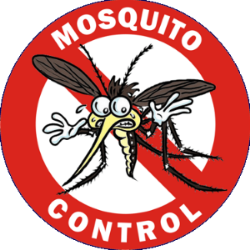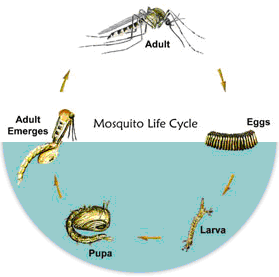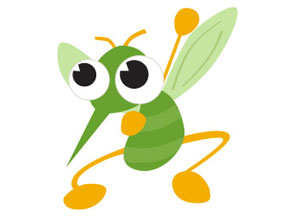 The Beautification and Facilities Division is responsible for mosquito abatement inside the City-Limits. Mosquito control is essential, not only to eliminate the biting nuisance, but to reduce the risk of viruses such as West Nile and Zika. We spray/fog with a chemical utilizing a truck mounted ULV (Ultra Low Volume) fogger, which is ideal for eliminating both adult mosquitos as well as their larvae. Spraying typically occurs one to two times per week, unless weather dictates otherwise. We attempt to blanket multiple neighborhood areas each week. It generally takes two or three weeks of spraying to reach all areas within the city limits.
The Beautification and Facilities Division is responsible for mosquito abatement inside the City-Limits. Mosquito control is essential, not only to eliminate the biting nuisance, but to reduce the risk of viruses such as West Nile and Zika. We spray/fog with a chemical utilizing a truck mounted ULV (Ultra Low Volume) fogger, which is ideal for eliminating both adult mosquitos as well as their larvae. Spraying typically occurs one to two times per week, unless weather dictates otherwise. We attempt to blanket multiple neighborhood areas each week. It generally takes two or three weeks of spraying to reach all areas within the city limits.
To help, we ask residents to please check their property for any standing water in buckets, tires, or debris and remove it to prevent mosquito larvae from hatching.
City residents can also pick up a mosquito brick from Public Works for use in standing water, such as ditches and ponds. Please bring your ID with you when picking up the brick so that we can verify your address.
Mosquito bricks, or dunks, contain Bacillus thuringiensis (Bti), a bacterium that is only toxic to mosquito larvae. They are non-toxic to other animals, including fish, birds, pets, and humans. Mosquito bricks are safe to use in backyard ponds, fountains, bird baths, and water gardens. They can also be used in animal watering troughs and fish habitats.
Please contact (843) 665-3236 to submit a work order if you live in the City of Florence limits and need mosquito control assistance.
NOTE: If you are a beekeeper, please make sure to contact us so that we know your location in order to prevent spraying near your hives.
Click here to opt-out of Mosquito Spraying
General Information Regarding Mosquito Control:
Mosquito control manages the population of mosquitoes to reduce their damage to human health, economies, and enjoyment. Mosquito control is a vital public-health practice throughout the world and especially in the tropics because mosquitoes spread many diseases, such as malaria.
Mosquito-control operations are targeted against three different problems:
- Nuisance mosquitoes bother people around homes or in parks and recreational areas;
- Economically important mosquitoes reduce real estate values, adversely affect tourism and related business interests, or negatively impact livestock or poultry production;
- Public health is the focus when mosquitoes are vectors, or transmitters, of infectious diseases.
Disease organisms transmitted by mosquitoes include West Nile virus, Saint Louis encephalitis virus, Eastern equine encephalomyelitis virus, Everglades virus, Highlands J virus, La Crosse Encephalitis virus in the United States; dengue fever, yellow fever, Ilheus virus, malaria, and filariasis in the American tropics; Rift Valley fever, Wuchereria bancrofti, Japanese Encephalitis, chikungunya, malaria and filariasis in Africa and Asia; and Murray Valley encephalitis in Australia.
Depending on the situation, source reduction, biocontrol, larviciding (control of larvae), or adulticiding (control of adults) may be used to manage mosquito populations. These techniques are accomplished using habitat modification, pesticides, biological-control agents, and trapping. The advantage of non-toxic methods of control is they can be used in Conservation Areas.
 The mosquito life cycle is composed of four stages: eggs, larval, pupae and adult.
The mosquito life cycle is composed of four stages: eggs, larval, pupae and adult.
Stage 1: Eggs
Only female mosquitoes have the ability to lay eggs. In order to develop eggs, the female needs a blood meal. With each blood meal, the female can lay several hundred eggs. The eggs are laid in or around water and will attach to one another, forming a raft. Individual eggs will float independently. After 24 to 48 hours, the eggs will hatch and release larvae.
Stage 2: Larvae
Mosquitoes spend approximately seven days to complete the development of the larval stage depending on food and temperature conditions.
Stage 3: Pupae
A week to ten days after the eggs hatch, the larvae transform into pupae. At this time, they can breathe oxygen. However, they cannot feed (bite). Mosquitoes spend one to two days in the pupae stage.
Stage 4: Adult
Once the mosquitoes have reached adulthood, they will feed on nectar; only the female mosquito will seek out a blood meal for reproduction. The adult mosquito lives for a period of six to eight weeks. A female will lay several batches of eggs during her life.
What is Ultra Low Volume (ULV) fogging?
Vector fogging equipment is used predominately for the application of disinfectants, biocides, fungicides, and pesticides. Our foggers generate a fog or mist formed of Ultra Low Volume (ULV) droplets between 5-50 microns (μm) in diameter. Studies have shown that droplets of this size are ideal to tackle pathogens, vector carriers, and pests. In addition, formulations can be applied in concentrations of 10-90% and at flow rates of up to 0.5 liters per minute (30 liters per hour) making them more efficient in the Volume Median Diameter (VMD) spectrum.
- Conventional sprayers, reach insects less effectively than ULV technology. This is because conventional sprayers spray larger droplet sizes in between 100-200 microns, which don't fully cover the whole area being sprayed. Apart from the droplet size they produce, manual sprayers can be very time consuming and labor intensive. Although motorized versions spray quicker, they are not suitable for indoor use, as they leave surfaces very wet and produce exhaust gases. Manual sprayers are ideal when you need to pray close up, in places such as patio areas and gardens.
- Thermal Fogging, heats up pesticides or disinfectants mixed with oil producing a very dense and visible fog formed of droplets of around 10 microns in size. Thermal fogging is ideal for exterior use to disinfect, combat vector carriers and pests. This method of fogging is not suitable for applying in closed indoor spaces due to the exhaust gases they produce.
- ULV Fogging, works by compressing pesticides or disinfectants through a specially designed nozzle, producing a fine cold mist or aerosol. Electric portable versions are particularly ideal for indoor applications as they don't produce exhaust gases and are less noisy. These machines can apply both oil and water based solutions.
Vector and Pest Control
Vector carrying insects and pests such as mosquitoes, flies, fleas, mites, and cockroaches are the cause of most common biological disease transmissions in the world today. It is generally accepted by industry professionals that fogging is the most efficient method of control, as only small amounts of pesticides get used in the process.
Flying Insects
Mosquitoes like the Aedes aegypti and flies such as the Black fly, form a major group of disease carrying vectors. These transmit a huge number of infectious diseases to humans, including Malaria, Dengue fever, Yellow fever, Typhus, and the Zika virus. Flying insects can also affect livestock and destroy crops having a damaging effect on agriculture. Examples include Mosquitoes, Blow Flies, Bottle Flies, Stable Flies, Fruit flies, Bean Flies, and Lygus. Thermal fogging is used to control the population of these insects in towns and farms.
Household Insect Pests
Red mite Livestock parasites can be detrimental to livestock production. As animal production has become more intensive, the threat of parasitic disease has also increased. These parasites range from flying insects to lice and mites which feed on the blood, skin, and hair of animals. These include Mosquitoes, Black flies, Hog Lice, Itch Mite, Ear Ticks, Sticktight Fleas and Red Mites. Hog lice for example can carry swine flu or swine pox, whilst Red Mites feed around the breast and legs of hens, causing pain, irritation, and decreased egg production. Fogging can be used to eradicate parasites living in empty sheds or stables prior to housing. Continuous disinfection of livestock housing using a fogger tends to be done through the breading cycle.
Disinfection
Pathogenic microbes such as viruses, fungi, and pathogenic bacteria are the main cause of airborne or direct contact diseases affecting animals and humans. Studies show the application of disinfectants and biocides via aerosol or fogging significantly reduces the number of viable infectious pathogens. Foggers produce micro droplets that float in the air for around 10 minutes after application, reaching the most inaccessible parts where conventional cleaning or spraying can't reach.
Pathogenic Bacteria
Ecoli Pathogenic bacteria contribute to many illnesses and infections whether food borne, water borne, or air borne. These include diseases such as E-coli, MRSA, C. difficile, Campylobacter, Legionella, and Salmonella. Unhygienic food preparation, water storage, and air conditioning systems can harvest as well as spread these diseases. Bacteria such as MRSA and C. difficile are especially troublesome in hospitals, prisons, and nursing homes, where patients with open wounds, and weakened immune systems are at greater risk of infection.
Virus
Influenza Viral infections make up around one third of cases of food poisoning in developed countries. Examples of these viruses include the Norovirus and Rotovirus. Other common viral infections include cold viruses and Seasonal influenza (the flu). An increasing concern due to a growing global population are animal or bird to human transmissions such as H1N1 (swine flu), and H5N1 strain of bird flu. Disinfection of surfaces using a fogger is essential to stop the spread of these infections.
 Fast Facts
Fast Facts
Scent, Sight, and Heat
Mosquitoes locate blood hosts by scent, sight and heat. From 100 feet away (30 meters) mosquitoes can smell your scent, especially the carbon dioxide (CO2) you exhale. Biting flies are even better; they can smell their prey from 300 feet (100 meters) away. Because CO2 is present in the atmosphere (plants take in CO2 and give off oxygen), mosquitoes respond to higher-than-normal concentrations, especially when the CO2 is mixed with host-odor. They follow your scent upwind, and can see you at a distance of about 30 feet (10 meters).
A Prolific Species
One female mosquito may lay 100 to 300 eggs at a time and may average 1,000 to 3,000 offspring during her life span. Mosquitoes breed in standing water, so eliminating standing water on your property reduces your risk. Areas like rain gutters, tree holes, old buckets or tires with stagnant water are breeding sites. However, although you may have taken steps to clear your property, you are subject to the actions or inactions of your neighbors, not to mention wetland areas in your community.
Fast Facts
- You're more likely to be a target for mosquitoes if you consume bananas.
- Mosquitoes prefer children to adults, and blondes to brunettes.
- Light colors are less attractive to mosquitoes than dark colors; thus, mosquitoes are more likely to choose a victim wearing darker colors.
- Mosquitoes dislike citronella because it irritates their feet.
- Biting activity increase by 500 times when there is a full moon.
- A mosquitos wings beat 500 times a second.
- The average life span of a female mosquito is 3 to 100 days. The male lives 10 to 20 days.
- The animal responsible for the most human deaths world-wide is the mosquito.